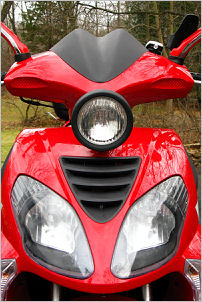Adding auxiliary lights to your Scooter
When it comes to adding lights to a scooter, there are three questions to answer:
- Is there any point?
- Can your alternator/battery handle the extra load?
- Is it legal?
What's the point?
There are two reasonable reasons for adding extra lights to a scooter. The first is to be seen and the second is to see better. If you just want to be seen, you don't need high power lights. You can buy strips of LEDs which are easy to attach and which typically draw only a small amount of power. A 10-light strip might draw about 300mA (1/3 amp) at 12v. You can get red LEDs for the back, or amber LEDs for the front and/or side of the scooter.
A second reason for adding lights is in order to see better. The standard headlight on many scooters is somewhat feeble and some auxiliary lighting can be quite useful at night. A light powerful enough to help with night driving will probably draw quite a lot of power. A 55W light, which is the smallest likely to be of much use) draws around 4 amps.
Back in the 1960s and 70s in the UK it was the fashion to add lots of lights and mirrors to scooters for decorative purposes. Thankfully that era is pretty much over!
Can you handle the extra electrical load?
Scooters don't usually have a very high capacity alternator/magneto and the battery is typically quite small, with something like a 5 Amp.Hour rating. On many scooters the headlights run directly off the alternator/magneto, while turn signals and the brake light (plus any "running lights") operate off the battery. The alternator/magneto also charges the battery of course. Adding extra load could run the battery down if the alternator/magneto can't supply enough current to run the lights, plus replace any charge drawn off the battery.
I have fitted a 55W light to my scooter which draws its power from the battery. It doesn't seem to run the battery down while the engine is running at normal riding speeds, though I haven't run it for more than about 1 hour.
Is it legal?
Every jurisdiction (state or local) seems to have their own rules and regulations about vehicle lighting. Many state the acceptable colors (white or amber visible from the front, red or amber visible from the rear). Some regulate the number of "headlights", some regulate "driving lights" and some regulate "fog lights". Regulations can include maximum power, whether the auxiliary lights can be on when the headlights are on, some regulate the mounting position. There are usually rules about aiming lights so that they do not dazzle oncoming traffic. Generally there is a ban on using blue lights and generally there are regulations about whether lights must be continuous or not (flashing lights). In some states, the use of "fog lights" when there is no fog is an offense. There's no single set of rules that covers everyone so all I can suggest is that you do a "Google" search for lighting regulations in your state.
Adding an Auxiliary Light
 On my scooter I added a 55W quartz-halogen light with a fairly wide beam. It's aimed down at the road maybe 25-35ft ahead of the scooter and provides significantly better illumination of the ground than using the headlights alone. Installation was pretty simple. I just drilled a small hole in the fairing above the headlights and mounted the light via the supplied bolt. I drilled a second small hole for the wiring to pass through. There are just two wires. One goes to ground and the other goes to the Positive (+) battery terminal via a switch and a fuse. It may be difficult to find just one light as they tend to come in pairs for use on cars and trucks, but sometimes you can find individual lights.
On my scooter I added a 55W quartz-halogen light with a fairly wide beam. It's aimed down at the road maybe 25-35ft ahead of the scooter and provides significantly better illumination of the ground than using the headlights alone. Installation was pretty simple. I just drilled a small hole in the fairing above the headlights and mounted the light via the supplied bolt. I drilled a second small hole for the wiring to pass through. There are just two wires. One goes to ground and the other goes to the Positive (+) battery terminal via a switch and a fuse. It may be difficult to find just one light as they tend to come in pairs for use on cars and trucks, but sometimes you can find individual lights.
It may be of more use to have a light with a relatively wide beam which can illuminate the area directly ahead of the scooter than a narrow beam that illuminates the road 1/2 mile ahead. Such a long distance spotlight could dazzle oncoming traffic and may be illegal, especially if it's on all the time.
So called "driving lights" tend to have long distance, narrow beams, while "fog lights" often have a wider light spread and may be more useful on a scooter at lower speeds.
Again note that some lights may be sold as being "for off-road use only", which is to say that they may not be strictly legal for road use in all states.
Additional Resources
- Adding a 12v outlet to your scooter
- Adding an audible turn signal indicator to your scooter
- Adding a digital Speedometer to your scooter
- Scooter oil change
- Scooter maintenance